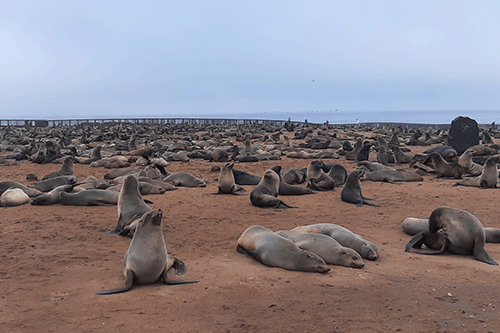This past Saturday marked the official start of the seal culling season in Namibia, which saw the fisheries ministry putting up a total of 86 000 Cape fur seals for harvesting until November this year.
As customary, the harvesting will take place onshore along the country’s coastal line and will see 80 000 pups and 6 000 bulls being harvested during the period.
Despite continuous condemnation and concerns raised by various environmentalists and associated groups, particularly with the culling methods and the number of seals harvested annually in Namibia, the ministry has maintained that harvesting is done responsibly and methodically.
Harvesting or culling methods involve clubbing pups over the heads, while the much bigger seal bulls are shot in the head.
Uaripi Katjiukua, the spokesperson of the fisheries ministry, shared with New Era that the country currently boasts a seal population of about 1.6 million, dispersed across 26 colonies along the coastline.
“As for their diet, their prey composition is examined through scats (faeces), collected monthly from both the southern and northern colonies. The studies done in 2021 and 2022 indicated that non-commercial species, especially bearded Goby, were the dominant prey in both regions,” stated Katjiukua.
Those figures, she said, strongly demonstrate that the seal population in Namibia is in a healthy and thriving state.
She said the ministry will continue to ensure the Cape fur seals are harvested responsibly and sustainably.
Namibian seal products are exported mainly to Asian markets, particularly to China, where seal bulls’ genitalia (penises) is a huge delicacy and in high demand.
Other countries, such as Canada, Iceland, Norway, Finland and Greenland have also approved annual seal harvesting for environmental and commercial purposes.
Economic value
Katjiukua explained the harvesting is done in accordance with set standards and within the perimeters of available data, especially when it pertains to the threats of a growing seal population against the country’s commercial fish stocks.
A seal overpopulation, the government argues, poses a serious threat to the fishing industry, which is a crucial sector for the Namibian economy.
It also leaves room for the seals to consume excessive amounts of fish that could have otherwise been for human consumption.
“The seal sub-sector is an important contributor to the development and advancement of our people. The sub-sector has eight right holders with 86 beneficiaries, who are all Namibians, and currently employs 105 people,” Katjiukua added.
There are currently only two factories that harvest seals in Namibia – one in Lüderitz and one at Henties Bay.
However, there have been complaints from local businesses that the current quota for seal bulls is insignificant, as there is no market for pups at all.
“If you also look at the quota for this season, you will see the bulls are few – and in actual fact, there is a demand for bulls, as their genitalia is very much sought after in Asia. There is also no direct market for Namibians to sell it, as we always have to do it through a middleman in South Africa,” said a coastal businessman, who spoke on condition of anonymity.
– ohembapu@nepc.com.na
Caption: Seal Culling –


